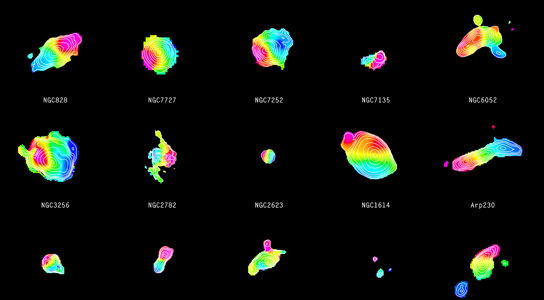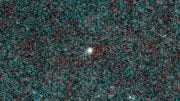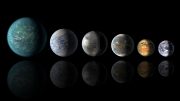
Each of the colorful objects in this image illustrates one of 30 merging galaxies. The contours in the individual galaxies show the signal strength from carbon monoxide while the color represents the motion of gas. Gas that is moving away from us appears red while the blue color shows gas that is approaching. The contours together with the transition from red to blue indicate a gaseous disc that is rotating about the center of the galaxy. Credit: ALMA (ESO/NAOJ/NRAO)/SMA/CARMA/IRAM/J. Ueda et al.
Using the Atacama Large Millimeter/sub-millimeter Array (ALMA) and several other radio telescopes, astronomers find direct evidence that merging galaxies can form disc galaxies instead of elliptical galaxies.
For decades scientists have believed that galaxy mergers usually result in the formation of elliptical galaxies. Now, for the first time, researchers using ALMA and a host of other radio telescopes have found direct evidence that merging galaxies can instead form disc galaxies, and that this outcome is in fact quite common. This surprising result could explain why there are so many spiral galaxies like the Milky Way in the Universe.
An international research group led by Junko Ueda, a Japan Society for the Promotion of Science postdoctoral fellow, has made surprising observations that most galaxy collisions in the nearby Universe — within 40–600 million light-years from Earth — result in so-called disc galaxies. Disc galaxies — including spiral galaxies like the Milky Way and lenticular galaxies — are defined by pancake-shaped regions of dust and gas, and are distinct from the category of elliptical galaxies.
It has, for some time, been widely accepted that merging disc galaxies would eventually form an elliptically shaped galaxy. During these violent interactions the galaxies do not only gain mass as they merge or cannibalize each other, but they are also changing their shape throughout cosmic time, and therefore changing type along the way.
Computer simulations from the 1970s predicted that mergers between two comparable disc galaxies would result in an elliptical galaxy. The simulations predict that most galaxies today are elliptical, clashing with observations that over 70% of galaxies are in fact disc galaxies. However, more recent simulations have suggested that collisions could also form disc galaxies.
This artist’s impression shows the merger between two galaxies leading to the formation of a disc galaxy. Upon merging, the shape of the galaxies is disturbed by their mutual gravitational interaction and results in a galaxy with a disc structure. Gas that is moving away from us appears red while the blue color shows gas that is approaching. The contours together with the transition from red to blue indicate a gaseous disc that is rotating about the center of the galaxy. Credit: NAOJ
To identify the final shapes of galaxies after mergers observationally, the group studied the distribution of gas in 37 galaxies that are in their final stages of merging. The Atacama Large Millimeter/sub-millimeter Array (ALMA) and several other radio telescopes [1] were used to observe emission from carbon monoxide (CO), an indicator of molecular gas.
The team’s research is the largest study of molecular gas in galaxies to date and provides unique insight into how the Milky Way might have formed. Their study revealed that almost all of the mergers show pancake-shaped areas of molecular gas, and hence are disc galaxies in the making. Ueda explains: “For the first time there is observational evidence for merging galaxies that could result in disc galaxies. This is a large and unexpected step towards understanding the mystery of the birth of disc galaxies.”
Nonetheless, there is a lot more to discover. Ueda added: “We have to start focusing on the formation of stars in these gas discs. Furthermore, we need to look farther out in the more distant Universe. We know that the majority of galaxies in the more distant Universe also have discs. We however do not yet know whether galaxy mergers are also responsible for these, or whether they are formed by cold gas gradually falling into the galaxy. Maybe we have found a general mechanism that applies throughout the history of the Universe.”
Notes
[1] The data were obtained by ALMA; the Combined Array for Research in Millimeter-wave Astronomy: a millimeter array consisting of 23 parabola antennas in California; the Submillimeter Array a submillimeter array consisting of eight parabola antennas in Mauna Kea, Hawaii; the Plateau de Bure Interferometer; the NAOJ Nobeyama Radio Observatory 45m (148ft) radio telescope; USA’s National Radio Astronomy Observatory 12m telescope; USA’s Five College Radio Astronomy Observatory 14m telescope; IRAM’s 30m telescope; and the Swedish-ESO Submillimeter Telescope as a supplement.
Reference: “Cold Molecular Gas in Merger Remnants: I. Formation of Molecular Gas Disks” by Junko Ueda, Daisuke Iono, Min S. Yun, Alison F. Crocker, Desika Narayanan, Shinya Komugi, Daniel Espada, Bunyo Hatsukade, Hiroyuki Kaneko, Yuichi Matsuda, Yoichi Tamura, David J. Wilner, Ryohei Kawabe and Hsi-An Pan, 12 August 2014, The Astrophysical Journal.
DOI: 10.1088/0067-0049/214/1/1
arXiv: 1407.6873









So–it’s possible that, when our spiral galaxy collides with spiral M31, the result will be another spiral, & not the gas-depleted elliptical we’ve been presented with in those displays. Possible good news for star formation!
One looks like a penis, one looks like a fish, one looks like a whale. Better than Rorschach blobs in my opinion!